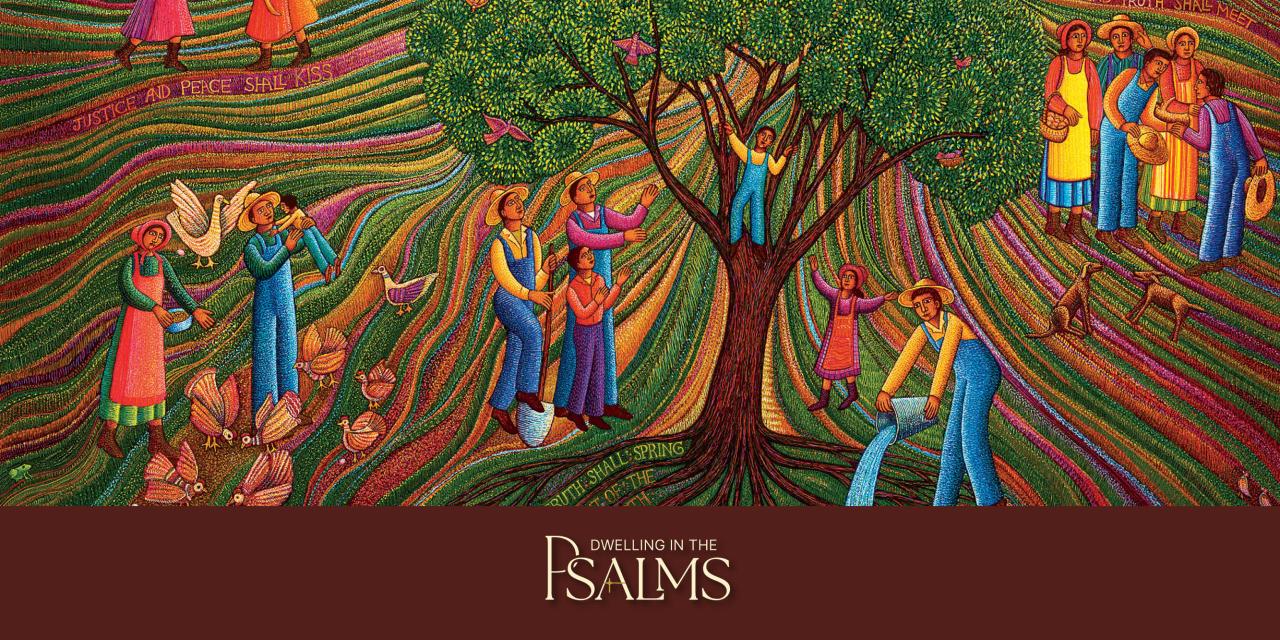Carol Arend is associate director of pastoral care and weddings at St. Thomas More Catholic Community in St. Paul, Minnesota. She also served on the team that implemented the congregation's 2020 Vital Worship Grant from the Calvin Institute of Christian Worship. In this edited conversation, Arend explains how the grant helped welcome more people into and through the art of accompaniment.
How do you explain the art of accompaniment to someone who's never heard it applied to a faith community?
It's like piano accompaniment in that you're there but not taking over. The term comes from Pope Francis in books such as his The Joy of the Gospel: Evangelii Gaudium (2013) and The Joy of Love (Amoris Laetitia): On Love in the Family (2016).
The art of accompaniment is a role for all the baptized, not just clergy, staff, and liturgical or lay ministers. In a faith context, accompaniment is about getting people to where God wants them. It requires listening with your heart, discerning what the Father is calling us to, and trusting that God is working in the person and through the situation. It's important to remember that we accompany in God's time, so it's an art that can't be rushed.
When did St. Thomas More Catholic Community start talking about accompaniment?
We started talking about it before we knew about accompaniment as a pastoral theology or knew about the Vital Worship Grant program. A woman in our congregation lost her middle-aged husband suddenly, leaving her with four kids. We were able to connect her with an older widow. Then someone else offered to accompany people through the emotions of seeking annulment because of what we Catholics would call an "irregular marriage," such as in cases of divorce and remarriage.
I caught wind of it as a framework for pastoral theology when a colleague and I went to a talk by Bill Huebsch on the art of accompaniment. He is a noted speaker, author, and consultant on explaining Catholic theology and practice in plain language. Bill's study guides on Pope Francis's The Joy of Love and The Joy of the Gospel are like the CliffsNotes of those exhortations. His book Promise and Hope: Pastoral Theology in the Age of Mercy: Discerning and Becoming a Parish of Accompaniment is a teaching book about the art of accompaniment and related pastoral theology.
What happened after you heard Bill Huebsch speak about accompaniment?
Accompaniment sounds like a no-brainer thing for a church to do, but it really helps to provide language for meeting people where they are in their faith journeys. We in the Catholic church tend to be legalistic: "We’ve got our rules!" But accompaniment means welcoming people with mercy, whether they are every-Sunday Mass goers, in an irregular marriage, or haven't been in church since they got married. So we organized Promise and Hope study groups for about fifty volunteer leaders and pastoral council people in our parish, and we applied for a Vital Worship Grant so our Catholic community at St. Thomas More could examine our worship practices and faith journeys through the lens of accompaniment.
How did your grant project introduce the whole parish to the art of accompaniment?
The grant helped us buy more copies of Promise and Hope and invite everyone in the parish to trainings. The idea of accompaniment really takes off when people are able to share their lives and stories in and around the liturgy. The pandemic has made this challenging because we had to switch to online training with Bill. Still, about fifty people came, and that really helped extend the training beyond paid non-ordained staff such as lay ministers. Also our two preaching priests and the two laywomen who do gospel reflections during Mass all are really good about bringing accompaniment into their sermons and reflections.
Bill Huebsch taught your parish about four levels of accompaniment. How do those play out in real life?
Everything about Jesus was accompaniment. Bill talked with us about how we can accompany others at home or on the streets. Our neighborhood has five colleges, so it is one of the most highly educated neighborhoods in Minnesota. However, we are close to less affluent and less educated neighborhoods. Those active in our parish tend to be college educated and middle to upper middle class. We have a good range of ages, both married and single. We are pretty white, though. Viewing our lives and worship through the lens of accompaniment requires asking whether we exist for everyone or just for the people "in the club."
We start with the first level of accompaniment—our family and friends, close neighbors, and co-workers—and then work out from there. The second level is people in our parish (and their spouses or partners) who come in and out of here once in a while, like for a wedding, funeral, or first communion. We might not know their names or faces. The third level is people who ask the parish for help, though they are strangers to us. Extending the art of accompaniment to the fourth level means extending outreach to those outside the parish proper as well as those suffering prejudice, illness, and difficulty. We consider our anti-racism work as fourth level accompaniment, because it's a way of working to better the whole.
Your grant poster mentions introducing a litany of welcome.
Yes. During our grant year, we started using a litany of welcome to open every Mass. The wording is similar to the one in Promise and Hope. But while that one uses many specifics—including people who are divorced, disabled, disfigured, living with shame, worried about kids—we made it shorter and more general, because once you start naming specifics, then people start to wonder why you left out certain categories. However, our clergy often bring in perspectives of various people—such as people who are gay, single, or struggling single parents—into sermons and prayers.
We recently did a liturgy survey of our parishioners, and the litany of welcome was one of the most oft-mentioned practices. People love it. They say that many churches claim to be "friendly." Yet we all know that "Minnesota nice" is often nice only till you go deeper. But this litany makes parishioners feel like St. Thomas More Catholic Community really welcomes everyone.
What is the wording? Does the whole congregation say it together?
The clergy presider opens mass with these words:
To those who celebrate with us today,
wherever you are on your faith journey:
you belong to us because you belong to Christ.
Christ is the host here today.
Christ sets the table.
Christ is the food and Christ welcomes all.
I can see that it could be powerful to all say it together.
How has your parish grown in the art of accompaniment?
One question that has arisen is: how do we accompany those who have little experience with the Catholic church and might feel uncomfortable at a particular liturgy? Are there ways to include them in our community's life of prayer and draw them toward the sacraments without making them feel like outsiders? This relates in some degree to both families at our school and non-Catholic spouses.
That's why we've changed the way we prepare families for baptism and faith formation. It used to be that parents who wanted a baby baptized would sign up for a class we give once a month. But now our two clergymen meet with each individual couple. They ask the parents, "Where are you on your faith journey? Where do you think God is calling you next? If you don't have a home parish, we would love to have you." Clergy also ask, "Is anything holding you back from participating more? How can we help?"
How do parents respond?
Many say, "No one has ever asked me those questions before." And they seem to appreciate it. It frees non-Catholic parents to ask questions they might never have dared to ask before. Sometimes one or both members of a couple has remarried before having a previous marriage annulled. They ask for help to regularize their union so they may receive communion.
These sound like potentially problematic conversations.
Yes, we need to do them without being judgmental or putting conditions on people. So, for example, we will baptize a child even if the parents haven't been here since their marriage or if they are in an irregular marriage. We will baptize a child even if the parents aren't married to each other. In some places, they would not be welcome. But in the art of accompaniment, we realize that we need to meet them where they are. Otherwise, how will they ever eventually do the right thing? The key is to remember that God is already active and present in their lives.
Showing genuine interest in these conversations and starting each Mass with the litany of welcome has made a difference. People who hadn't been coming to mass are coming now. We always have worship aids [orders of worship] at worship so people have words to follow.
How have you practiced the art of accompaniment in worship during the COVID-19 pandemic?
When the pandemic started, we hopped online right away so that as many people as possible could worship together through Facebook Live. Even the oldest people in our parish joined Facebook. Even after we returned to socially-distanced, in-person worship, we've continued to do a lot online. To stay safe and healthy we only offer Eucharist in the form of bread.
We've tried to create common experiences during times we can't gather. During Advent 2020 we sent home kits that included cards with beautiful Advent prayers; a recipe to make a spiral Advent wreath of dough; and candles to insert in the Advent wreath. During Advent 2021, we sent home beautiful cards with O Antiphon prayers and Epiphany chalk that had been blessed so people could mark their door lintels as a sign of God's protection.
How have you accompanied people in their daily lives during the pandemic?
Our staff and volunteers did two rounds of phone calls to every parish member. In January 2022 we did a third round of calls to every parishioner aged 70 and older. Some parishioners donated gift cards to grocery stores, so we were able to offer those. Our young adult group (ages 39 and under) offered to run errands. Some folks accepted one or both types of help.
LEARN MORE
Read St. Thomas More Catholic Community's grant poster. Learn more about the art of accompaniment. Listen to a parishioner's testimony about being accompanied (6:39).

